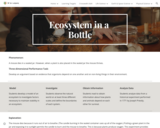
A Powerpoint guided lesson about ecosystems and the role of producers and consumers (April Mitchell)
- Subject:
- Science
- Material Type:
- Lesson
- Provider:
- 3D Sci Lessons
- Date Added:
- 10/24/2021

A Powerpoint guided lesson about ecosystems and the role of producers and consumers (April Mitchell)
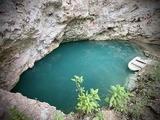
This lesson plan utilizes the use of mobile devices for digital photography to enhance student learning. Students will be learning about Ecoturism, comparing and contrasting geographical landscapes in different parts of Latin America. This lesson is meant to be taught in Spanish, but can be adapted to other languages. (Thumbnail image: Cenote Santa Cruz, Homun, Yucatan, Mexico, Abril 2021, by Sharon Hahn Darlin: CC-BY-2.0 CC, from Wikimedia Commons)

This EdCamp is a collaboration between Alpine, Provo, Nebo, and Juab school districts and Utah Valley University. An EdCamp is a free public events that leverages the knowledge and experiences of attendees by allowing educators to collaboratively determine topics for discussion the day of the event. Educators facilitate sessions by using their experiences to drive conversation with their peers. Educators are encouraged to find EdCamp sessions that best meet their needs to maximize learning.

Two professors in Instructional Psychology and Technology at BYU will discuss successfully designing effective and engaging learning environments with graduate-level open textbooks.

List of competencies that outline best practices for digital teaching and learning in the classroom. This list is also the requirements for the Ed Tech Endorsement.
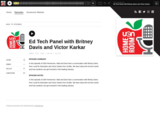
In this episode of UEN Homeroom, Matt and Dani have a conversation with Britney Davis from Lucid for Education and Victor Karkar from Scrible. We learn about the ed tech world and how students can get involved in this leading industry.
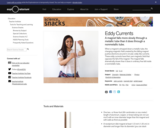
In this activity related to magnetism and electricity, learners discover that a magnet falls more slowly through a metallic tube than it does through a nonmetallic tube. Use this activity to illustrate how eddy currents in an electrical conductor create a magnetic field that exerts an opposing force on the falling magnet, which makes it fall at a slower rate. This activity guide also includes demonstration instructions involving two thick, flat pieces of aluminum to illustrate the same principle.
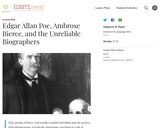
We are naturally curious about the lives (and deaths) of authors, especially those, such as Edgar Allan Poe and Ambrose Bierce, who have left us with so many intriguing mysteries. But does biographical knowledge add to our understanding of their works? And if so, how do we distinguish between the accurate detail and the rumor; between truth and exaggeration? In this lesson, students become literary sleuths, attempting to separate biographical reality from myth. They also become careful critics, taking a stand on whether extra-literary materials such as biographies and letters should influence the way readers understand a writer's texts.

This video explains how to edit your profile in Pressbooks.

Learn how to add, remove, or rearrange questions within a Derivita assignment.

This video provides practical tips on the art of editing and when to use them in your film projects. For more Media Education programming, please visit www.utahfilmcenter.org/education

In this video from Science City, meet Eduardo Torres-Jara, a postdoctoral associate in electrical engineering and computer science at the MIT Artificial Intelligence Lab. He describes his work on innovative robots that use tactile feedback to locate and grasp objects.

The Education Hazards of Generative AI provides a basic scientific overview of how largelanguage models (LLMs) work and connects this knowledge to practical implications for educators. This document is intended as a resource for teachers, principals, school district administrators, parents, students, policymakers, and anyone else thinking about using generative AI for educational purposes.

Application for the Utah Education Technoloty endorsement
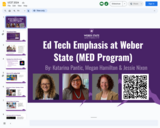
Information about the Ed Tech emphasis in the MED program at Weber State
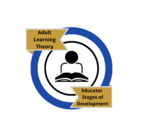
Educators’ development and growth is foundational in directly impacting student learning and success. This microcreditional focuses on educator stages of development and differentiating instructional coaching practices when working with educators. Also, considering adult learning theory practices when working with educators is essential for honoring educator experience and meeting educator development needs.

This blog post breaks down the basics of copyright, fair use, the public domain, and Creative Commons, particularly as applicable to educators and students.

This guide explains the basics of copyright and fair use and why it is important for educators and students to learn about copyright.

This collection has been carefully selected by New York City educator and curriculum consultant Vivett Dukes to showcase ideas, achievements, and contributions by American people of all backgrounds across eras. The content highlighted within each topic is intended to expand the scope of voices traditionally centered in classroom curricula by elevating stories by and about Black, Indigenous, and People of Color. These resources are intended to inspire educators to use PBS LearningMedia intentionally and creatively to teach topics across all subject areas. For additional resources, lesson plans, worksheets, and professional development content rooted in skills supporting critical media literacy, visit Expanding Narratives Using Media: A Planning Kit.
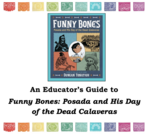
This guide to the story Funny Bones: Posada and His Day of the Dead Calaveras by Duncan Tonatiuh provides educators with synopsis, reviews, and lesson activities for teaching and discussing the story in the classroom, complete with a list of related core standards.